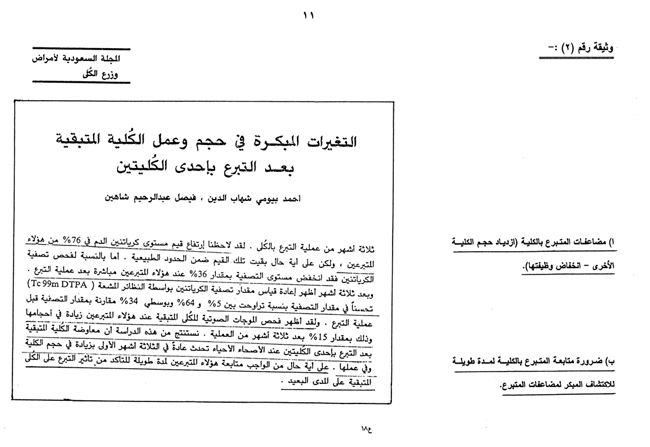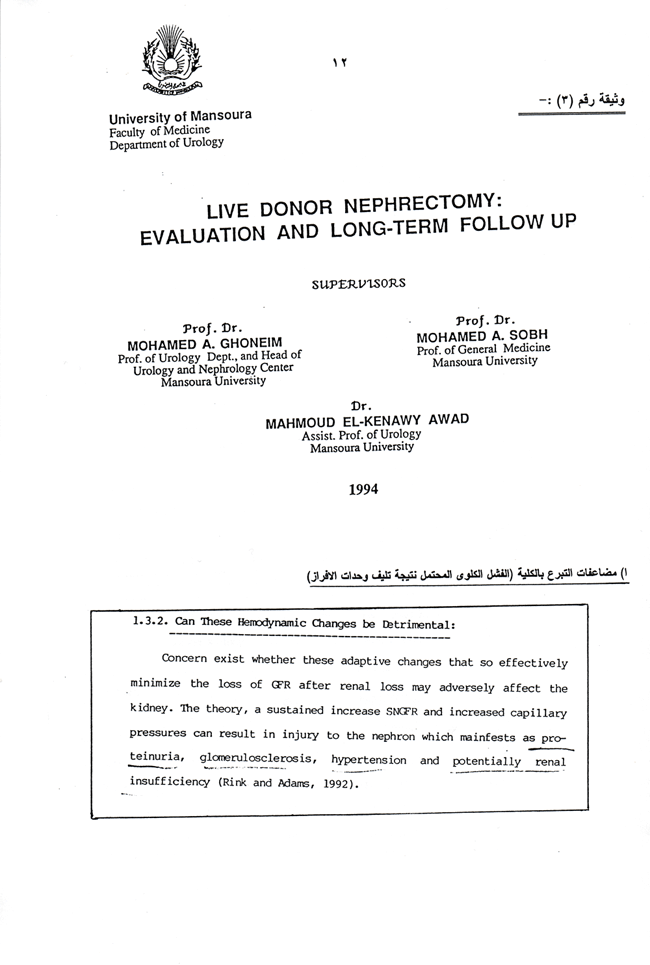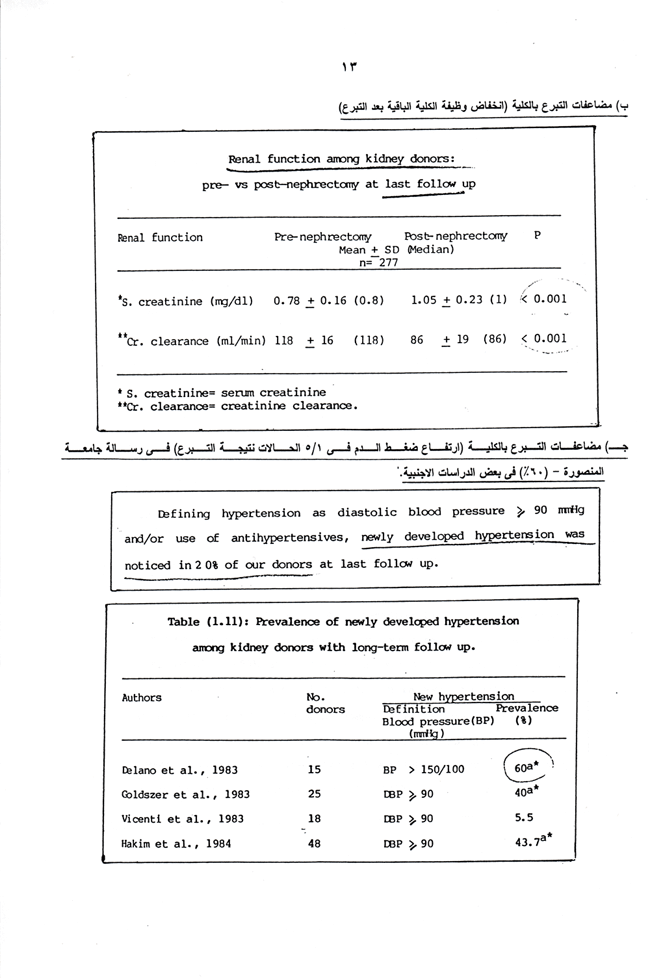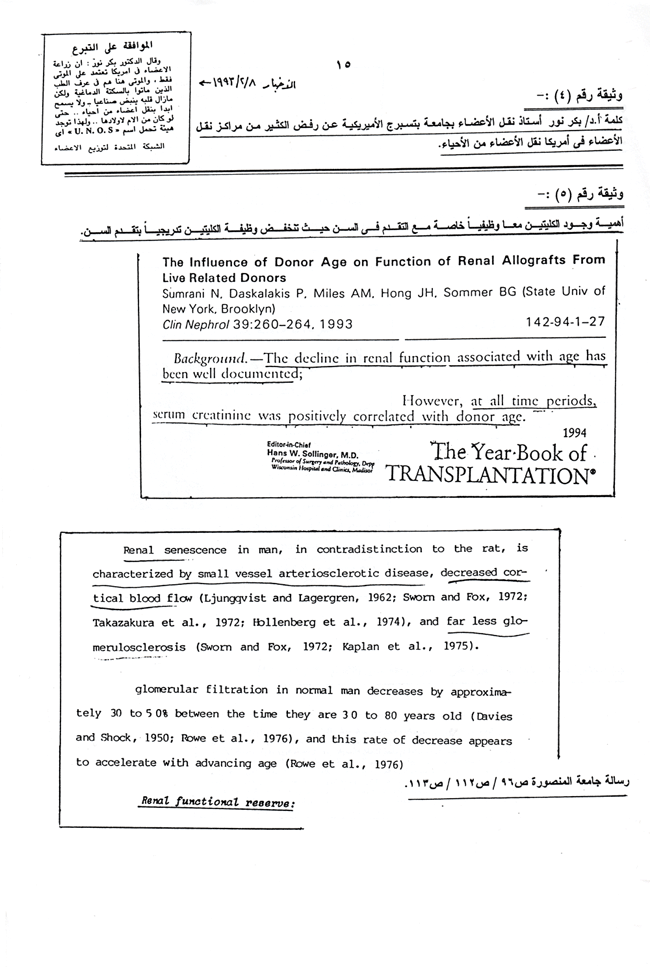|






BMJ 1998;316:846-848 ( 14 March )
Education and debate
Personal paper
Risk of diabetic nephropathy in potential
living related kidney donors
D Simmons,
senior lecturer in medicine,
M Searle,
renal physician.
University of Auckland, Middlemore Hospital,
Private Bag 93 311, Auckland 6, New Zealand
Correspondence to: Dr Simmons
Diabetic nephropathy is the leading cause of
end stage renal failure in New Zealand.1
Cadaveric organs are in short supply
here, as elsewhere, and we need to consider
living related donation. Kidneys from
living related donors also provide a better
graft and improved survival of
transplant patients. However, donors
from ethnic groups who have a high incidence of
end stage renal failure because of
diabetes and glomerulonephritis are also at
increased risk of developing diabetes.2
This risk is compounded by
environmental factors such as obesity. In New
Zealand the ethics of living related
donation within the diabetic family are being
questioned.
Renal transplantation is preferred to dialysis in diabetic
patients who are fit enough for surgery. It is
associated with an improved quality
of life, lower morbidity and mortality, reduced
long term costs, and greater incremental
benefit in diabetic patients compared
with patients without diabetes.3
The main reason for not transplanting
kidneys into suitable candidates is the low
availability of compatible organs for
transplantation. Some ethnic groups
object to donating body parts after death for
cultural and spiritual reasons. The
resulting underrepresentation of these
ethnic groups in the donor pool further
reduces the likelihood that patients
with end stage renal failure from these ethnic
groups will receive an organ. Organ
donation from living relatives is
therefore particularly encouraged in these
groups.
Diabetes and the development of nephropathy once diabetes
has occurred are familial and cluster in
families.
4
5 It is therefore
important to be able to advise a potential donor
of his or her personal risk of
developing end stage renal failure.
|
 |
Risk factors for diabetes |
Apart from a few rare cases in patients with impaired
glucose tolerance, development of clinical
diabetes precedes the onset of
diabetic nephropathy. Undiagnosed diabetes may
already be present, but if it is not
there are four major predictors of future
diabetes ethnic
group, previous gestational diabetes, a
high titre of islet cell antibody
(for insulin dependent diabetes mellitus), and
impaired glucose tolerance (table).
The underlying prevalence of diabetes
is a major determinant of risk for both impaired
glucose tolerance and gestational
diabetes. In those aged 30-64 years, the
prevalence of non-insulin dependent
diabetes varies from 1% to 50% between
ethnic groups.6
The prevalence also varies within the same
ethnic group in different geographical
locations.6
The risk of diabetes in terms of
familial relationship and type of diabetes
in different ethnic groups is shown in the
table. ethnic
group, previous gestational diabetes, a
high titre of islet cell antibody
(for insulin dependent diabetes mellitus), and
impaired glucose tolerance (table).
The underlying prevalence of diabetes
is a major determinant of risk for both impaired
glucose tolerance and gestational
diabetes. In those aged 30-64 years, the
prevalence of non-insulin dependent
diabetes varies from 1% to 50% between
ethnic groups.6
The prevalence also varies within the same
ethnic group in different geographical
locations.6
The risk of diabetes in terms of
familial relationship and type of diabetes
in different ethnic groups is shown in the
table.
Prospective studies have shown that other components of the
metabolic syndrome are risk factors for
developing diabetes. In the eight
year follow up of the middle aged cohort of the
San Antonio heart study, 34% of
hypertensive people and 30% of overweight
subjects went on to develop non-insulin
dependent diabetes mellitus or
impaired glucose tolerance (compared with 15% of
people without hypertension and 10%
of those with a normal weight).7
Other risk factors for the
development of non-insulin dependent diabetes
include the degree of fasting
hyperglycaemia and hyperinsulinaemia
after an oral glucose load.
8
9
Among Pima Indians, a family history of diabetic
nephropathy is itself a risk factor for the
development of diabetes.10
The risk of developing non-insulin
dependent diabetes mellitus is three
times greater where both parents have diabetes
and one has renal disease than where
both parents are diabetic but neither
has kidney disease. If this applies to other
ethnic groups, the people who are
most likely to be asked to give kidneys may be
those with the highest chance of
developing diabetes (and possibly
nephropathy).
|
 |
Risk factors for development of
nephropathy |
Only a proportion of people with diabetes progress to
nephropathy and then to end stage renal failure.
Many of the modifiable risk factors
for diabetic nephropathy depend upon the quality
of health care and self care (for example,
blood pressure, glycaemia, smoking,
and obesity).11
Ethnic and familial factors are also
important for determining those with diabetes
who will probably develop
nephropathy. While few (around 0.4%) Europeans
with non-insulin dependent diabetes
mellitus develop end stage renal failure,12
overt nephropathy occurs in up to 50% of
Pima Indians who have had non-insulin
dependent diabetes mellitus for more than
20 years.13
Ethnic groups at high risk of diabetes
related to end stage renal failure
often have a relatively high prevalence of
microalbuminuria but are not overtly
diabetic, and this should be considered by
any potential donor. A parental history of
hypertension is associated with an
increased the risk of microalbuminuria.14
The findings of the study by Seaquist et al are of
particular concern.5
The development of nephropathy and end stage
renal failure was compared in the
diabetic siblings of insulin dependent
diabetics with and without end stage renal
failure.5
Although 17% of siblings of subjects
without nephropathy developed albuminuria,
most of the siblings of patients with
diabetic nephropathy developed either
albuminuria (41%) or end stage renal failure
(41%).
Does having only one kidney increase the risk of
nephropathy?
The final and most relevant question is whether
having only one kidney increases the risk of
nephropathy should diabetes develop.
The few animal studies undertaken suggest that
the resulting hyperfiltration is
associated with increased renal morbidity.
15
16 Clinical studies
are few. Two follow up studies of patients with
either unilateral agenesis or
uninephrectomy included eight patients
with diabetes, two of whom experienced
progression of renal disease.
17
18 In two studies, one of
363 patients with non-insulin dependent
diabetes mellitus19
and the other of over 5000 patients with
both non-insulin dependent and insulin
dependent diabetes mellitus,20
the proportions of albuminuric patients
with reduced renal mass were 8% and
3% respectively. None of the patients without
albuminuria was known to have a
reduced renal mass (although these subjects
were not as extensively investigated as
the patients with albuminuria).
Unilateral renal agenesis occurs in
approximately 1/1000 births.21
Studies are urgently needed to investigate
this issue further.
|
 |
Assessment of the potential living
related donor |
The clinical information that needs to be collected for
assessment of the potential living related donor
is shown in the box. Clearly, the
risk of developing diabetic nephropathy in
relatives of those with insulin
dependent diabetes mellitus complicated
by end stage renal failure incorporates a
low risk of developing diabetes with
a high risk of developing nephropathy should
diabetes occur. The risk of diabetic
nephropathy in relatives of people
with end stage renal failure caused by
non-insulin dependent diabetes
mellitus is especially high in those with
impaired glucose tolerance and
previous gestational diabetes. Some ethnic
groups have a very high risk of
developing non-insulin dependent diabetes
mellitus, but a variable risk of
developing end stage renal failure, depending
on ethnic group. Other risk factors, such
as obesity and hypertension, may be
cumulative. The final calculation will be an
assessment of clinical risk rather
than of a true actuarial risk.
|
Assessment of the risk of diabetes
and subsequent nephropathy in
potential living related donors
Risk of diabetes
-
Age
-
Ethnic group
-
History of gestational diabetes mellitus
-
Impaired glucose tolerance
-
Family history of diabetes
-
Body mass index
-
Two hour oral glucose test to exclude diabetes and
impaired glucose tolerance
-
Fasting and two hour insulin measurements
-
Islet cell antibody status
-
Risk of nephropathy should diabetes develop
Risk of nephropathy should diabetes develop
-
History of renal disease or hypertension
-
Family history of diabetic nephropathy or hypertension
-
Smoking history
-
Blood pressure
-
Microalbuminuria
|
|
 |
Conclusion |
There may be an increased risk of developing nephropathy
after nephrectomy, but this has not been
quantified. The issues need to be
carefully discussed with potential living
donors, and clinicians need to
balance the immediate benefit to the intended
recipient with the possible harm,
some time in the future, to the potential
donor.

Clin Nephrol. 1993 May;39(5):260-4.
The
influence of donor age on function of renal
allografts from live related donors.
Sumrani N,
Daskalakis P,
Miles AM,
Hong JH,
Sommer BG.
Department of Surgery, State University of New
York Health Science Center, Brooklyn 11203.
To assess the influence of donor age on renal
allograft outcome, we retrospectively analyzed
all 169 consecutive cyclosporine-treated live
related donor kidney transplants, of whom 40
were HLA identical siblings. All recipients were
similar with respect to demographic and
immunologic characteristics. Incidence of
rejection episodes and graft survival rates at 1
and 5-year posttransplant were independent of
donor age. Best renal function, as assessed by
the mean of the lowest 3 serum creatinine
concentration levels in the first 2 months
posttransplant correlated positively with donor
age, particularly among HLA mismatched male
recipients (r = 0.4, P < 0.002). Short and
intermediate term renal function was inferior,
but stable in the older donor recipient group
when compared to the younger cohort. Mean serum
creatinine levels at 5 years in recipients of
kidneys from older donors (age > 55 years) was
2.6 mg/dl compared to 1.7 and 1.9 mg/dl in
recipients of kidneys from donors between the
ages of 18-39 and 40-54 years, respectively (P <
0.001). In view of the universal shortage of
organs and the negligible morbidity to the
donors, our results should not discourage the
use of kidneys from elderly (age > 55 years)
donors.

Cancer Detect Prev Suppl. 1987;1:149-57.
Neoplastic consequences of transplantation and
chemotherapy.
Penn I.
Department of Surgery, University of Cincinnati
Medical Center, OH 45267-0558.
An increased incidence of certain neoplasms
occurs in immunodeficiency states. The incidence
of cancer in organ transplant patients is
approximately 4%. The predominant tumors are
lymphomas, carcinomas of the skin and lips,
carcinomas of the vulva/perineum, in situ
carcinomas of the uterine cervix, and Kaposi
sarcoma (KS). Tumors appear a relatively short
time after transplantation. Unusual features of
the lymphomas are the high incidence of
non-Hodgkin lymphomas, frequent involvement of
extranodal sites, and marked predilection for
the brain. Skin cancers present unusual
features: predominance of squamous cell
carcinomas, young age of the patients, and a
high incidence of multiple tumors. Cancers of
the vulva/perineum occur at a younger age than
in the general population and may be preceded by
condyloma acuminatum or herpes genitalis.
Lymphomas, leukemias, and skin cancers are
increased in nontransplant patients who receive
immunosuppressive therapy for nonmalignant
diseases. Second tumors that develop in cancer
patients, after treatment with cytotoxic
therapy, are mainly leukemias, lymphomas, and
bladder carcinomas.

Int J Urol. 1998 Nov;5(6):521-5.
Malignant neoplasm in kidney transplantation.
Kishikawa H,
Ichikawa Y,
Yazawa K,
Hanafusa T,
Fukunishi T,
Ebisui C,
Okuyama A,
Nagano S.
Department of Urology, Hyogo Prefectural
Nishinomiya Hospital, Japan.
BACKGROUND: The kidney recipient is at a higher
risk for cancer than is the general population,
although the incidence of neoplasms in general
is considered lower in Japan than in Western
countries. The cause of this increased risk
associated with either transplantation or
geography has not yet been established. METHOD:
The incidences and sites of malignant neoplasms
were analyzed in 285 kidney recipients, who had
been followed up for 3007 patient-years. The
relationship between immunosuppressive states,
the numbers of CD4-positive T lymphocytes, and
the presence of malignant neoplasms was studied
retrospectively. RESULTS: Eighteen malignant
neoplasms were found in 17 of the 285 patients
(6%). The malignancies developed in these
patients an average of++ 1 26.5 months after
transplantation. The incidence was only 3.9% at
10 years, increasing to 13.9% at 20 years. No
difference in the time-course incidence was
found between azathioprine-based and cyclosporin-based
immunosuppressive regimens. The malignancies
developed in the digestive organs in more than
half of the patients, and were mainly in the
liver, colon and rectum, and stomach, with a
relatively low incidence of skin cancer and
lymphoma. There was only one case of
Epstein-Barr virus genome found in 5 specimens
that were tested. Concerning the
immunosuppressive state, CD4-positive T
lymphocyte counts were not related directly with
malignancies in our series. CONCLUSION: The
cumulative incidence of malignancy increased
markedly in the second posttransplant decade.
The site of cancers in kidney recipients mirrors
that of general Japanese malignancies. Our
results revealed neither the cause nor predictor
for malignancies in kidney transplant patients.

Adv Ren Replace Ther. 1996 Apr;3(2):147-53.
Home
hemodialysis: survival, quality of life, and
rehabilitation.
Oberley ET,
Schatell DR.
Medical Education Institute, Madison, WI 53711,
USA.
Choice of treatment modality for patients with
end-stage renal disease ideally should not only
increase the chances of survival but also
improve quality of life and facilitate
rehabilitation goals. These goals include
employment, enhanced physical functioning,
improved understanding of dialysis, increased
control, and resumption of activities enjoyed
before dialysis. Home hemodialysis has been
consistently associated with improved long-term
patient survival and quality of life compared
with patients treated with in-center
hemodialysis or peritoneal dialysis. Home
hemodialysis is also well suited to
rehabilitation. Home hemodialysis training
programs educate patients and partners to become
responsible for dialysis treatments, thus
encouraging independence and permitting flexible
scheduling, which promotes greater participation
in exercise and employment. Further information
about modality choice and rehabilitation
outcomes could be obtained by systematic data
collection to enable comparisons between
modalities. Patients should have the opportunity
to choose from among all modalities, including
home hemodialysis.

Adv Ren Replace Ther. 1998 Oct;5(4):267-74.
Daily hemodialysis: dialysis for the next
century.
Kjellstrand C,
Ting G.
Aksys, Ltd, Lincolnshire, IL 60069, USA.
ckjellstrand@aksys.com
There are currently over 150 patients receiving
daily hemodialysis in over 12 centers worldwide.
The experiences of over 200 daily hemodialysis
patients spanning 30 years have been reviewed.
The reports uniformly describe subjective and
objective improvements. There are decreased
symptoms during and after dialysis, improved
functional status, and better quality-of-life
ratings. There are improved nutritional indices,
improved blood pressure with fewer blood
pressure medications, and improved hematocrit
with reduced transfusion or eythropoietin
requirements. There also appear to be economic
advantages, related to the significant
reductions in the need for recombinant human
erythropoietin and blood pressure medications.
Early data suggest that there may be a
significant decrease in days of hospitalization
for very ill patients as well. This is important
clinically and financially when the global costs
of caring for dialysis patients are considered.
Substantial issues remain before daily
hemodialysis will be widely accepted. These
include logistical problems (additional time for
transportation, set up and disinfection),
economic problems (increased supply costs or
labor associated with more frequent treatments),
and medical problems (deficiency syndromes and
blood access). Technological improvements are
close to overcoming many of the recognized
problems, although additional payor education,
research into deficiency syndromes, and an even
greater focus on creating natural arterio-venous
fistulae all need to occur before daily
hemodialysis is more widely accepted. We are
convinced, however, that daily dialysis will be
increasingly used in the next century because it
is more physiologic, makes many patients feel
much better, produces better outcomes, and
decreases overall cost for end-stage renal
disease patients compared with current dialysis
regimes.

Am J Kidney Dis. 1998 Dec;32(6 Suppl
4):S76-82.
Comment in:
Am J Kidney Dis. 1998 Dec;32(6 Suppl 4):S86-7.
Daily hemodialysis: why the renewed interest?
Pierratos A.
Humber River Regional Hospital, University of
Toronto, Ontario, Canada. a.pierratos@utoronto.ca
There has been an increasing interest in new
hemodialysis regimens aiming to address issues
of inadequate dialysis, poor quality of life,
and poor outcomes. This article reviews the
current state of short daily and nocturnal
hemodialysis and outlines the advantages of
daily over conventional hemodialysis reviews.
Furthermore, it attempts to compare these two
dialysis regimens

|